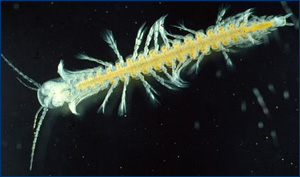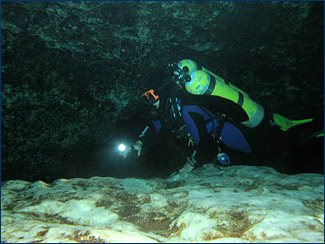

Joey Pakes will be heading to Mexico's Yucatan Peninsula to collect remipedes like Speleonectes, pictured here.
Remipedes and cave diving: Field notes from Joey Pakes
By UCMP grad student Joey Pakes, June 3, 2008
  Joey Pakes will be heading to Mexico's Yucatan Peninsula to collect remipedes like Speleonectes, pictured here. |
| Joey received an NSF Graduate Fellowship to support her study of the Remipedia, a group of animals that are relatively new to science — the first specimens were discovered in 1979. Since then, 17 species have been described, but many mysteries about their natural history remain. Joey's research will help answer basic questions about the biology of remipedes. |
My interests and plans
Since 2003, I have been utterly obsessed with an obscure little crustacean called the remipede. This animal, which looks a little like a white, eyeless centipede, is closely related to crabs and shrimp and has a deep history. One fossil remipede discovered in Texas probably lived more than 290 million years ago!
Lucky for me, a would-be globe-trotter, these animals have an awesome distribution. So far, remipedes have been found on Mexico's Yucatan Peninsula, in the Caribbean (Bahamas, Cuba, Dominican Republic, Turks and Caicos), on the Canary Islands off the coast of northwest Africa, and in western Australia. I hope to be able to study them in all these locations.
In all these locations, remipedes have only been found in anchialine caves. Anchialine caves are characterized by having a distinct halocline in which a lighter freshwater layer rests on top of a denser saltwater layer. Remipedes are associated with limestone caves that have a sulfide-rich layer at the halocline — quite a harsh environment when you factor in the toxicity of sulfur, low oxygen levels, and potentially low nutrient levels in these dark ecosystems. So naturally, I am curious about several aspects of remipede biology and ecology. Some of the questions I hope to answer are:
I'm now in my first year of grad school. With two invertebrate experts as advisors (Professors David Lindberg and Roy Caldwell of UC Berkeley), I finally have the support and time to start studying these little creatures. This summer, I will begin tackling my questions about remipede feeding habits in Mexico's cave systems. My research will use carbon and nitrogen stable isotope ratios of organisms within remipede-inhabited caves. The proportion of heavy and light carbon and nitrogen atoms (isotopes) within organisms differs based on how and from where the organism is getting its carbon and nitrogen. You can even guess what an animal is eating based on these ratios if you know the ratios of all the things it might eat. This is because stable isotope ratios are passed through the food chain (from prey to predator) in a predictable way. I would like to use these methods in my project, but first, I'll need to use SCUBA to collect remipedes, their potential prey (like fish, other crustaceans, and bacteria), and environmental data from Mexico's "cenotes," or caves. Back in Berkeley, I'll run dried and powdered tissue samples from these organisms through the machines in the Stable Isotope Facility. Once I know the carbon and nitrogen ratios for all the organisms I've collected, I should be able to use a model to figure out who is eating whom in the system and then see if food web relationships change due to the characteristics of the cave or the time of year.
Preparation
I recently returned from two weeks in Florida preparing for my upcoming trip to the Yucatan. I will be accompanying Professor Tom Iliffe from Texas A&M, a cave-diving expert who has discovered and studied many anchialine crustaceans over the last 25 years. But in order to go diving with him, I needed to learn SCUBA all over again — in caves! In Florida, Tamara Thomsen taught me the basics of cave diving.
 Joey works on her cave-diving certification in the Ginnie Springs cave system, Florida. Click on the image to see an enlargement. |
I have nine and a half years of open-water SCUBA-diving experience, but getting certified for technical diving in an overhead environment — one where there's no direct access to the surface or natural light — is still a big deal. Under such potentially dangerous conditions, one needs to be able to think critically and move horizontally to exit a cave.
My previous SCUBA experiences misled me into believing that I would feel natural in any diving environment. I definitely did not expect the mental and physical challenges of diving in overhead environments: complete darkness, confinement (a claustrophobe's nightmare!), operating a reel and line underwater (a tangle-prone version of Hansel and Gretel's bread crumbs), and diving with two heavy tanks instead of one (a backache waiting to happen).
Although my new friends each told me that learning to cave dive was one of the most frustrating times of their lives, I was completely unprepared for my first underwater cavern. I thought that I'd coast through the dive as I did through my open-water training. I emerged from the dive unexpectedly nauseated, with a pounding stress headache and no recollection of the cave I had just explored. Fortunately, by the end of the trip, I had gotten my wits together, become used to diving with two tanks, and was comfortable diving with harnesses and extra equipment. I finished off the trip by getting my cavern and introductory cave-diving certifications, the first two steps to becoming a fully certified cave diver.
Over the next few weeks, I will continue to prepare myself for diving in Mexico's caves and will report on my progress here. It should be an adventure and lead to some exciting data! Meanwhile, to learn more about remipedes, check out the introduction to Remipedia on the UCMP website.
Photo of Joey at the wheel courtesy of Joey Pakes; Speleonectes photo © Jill Yager, Antioch College; Joey diving in Florida by Ethan Brodsky.